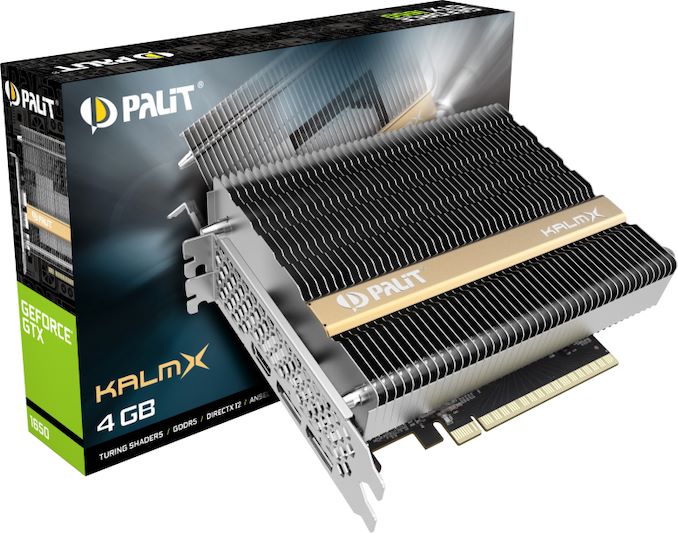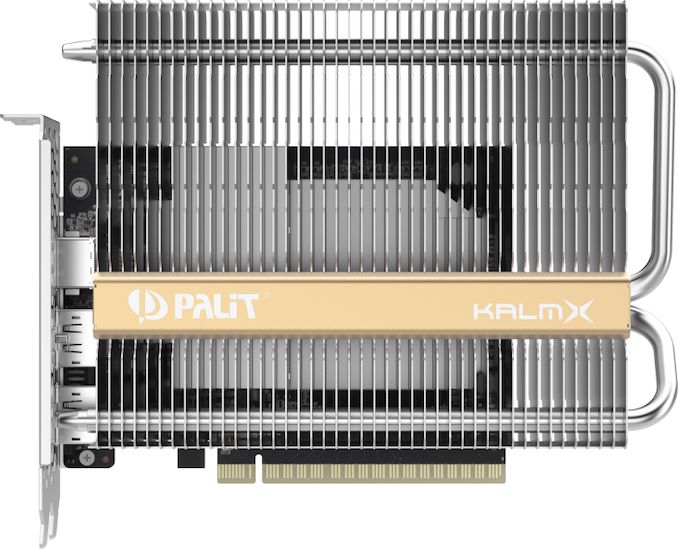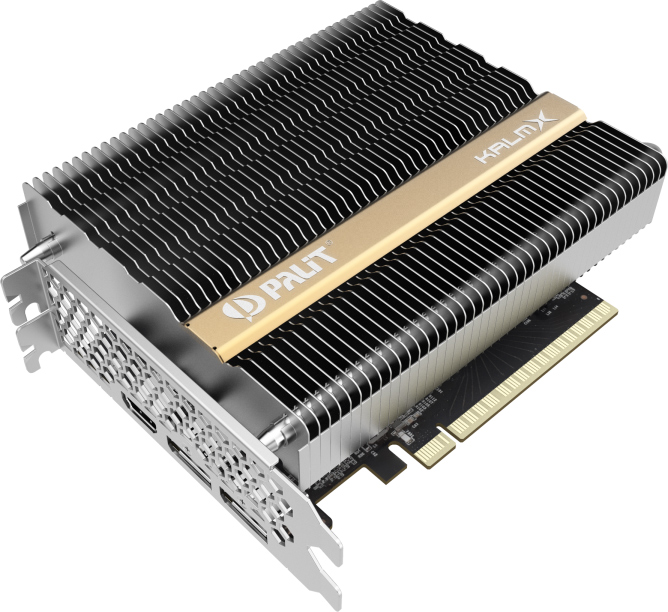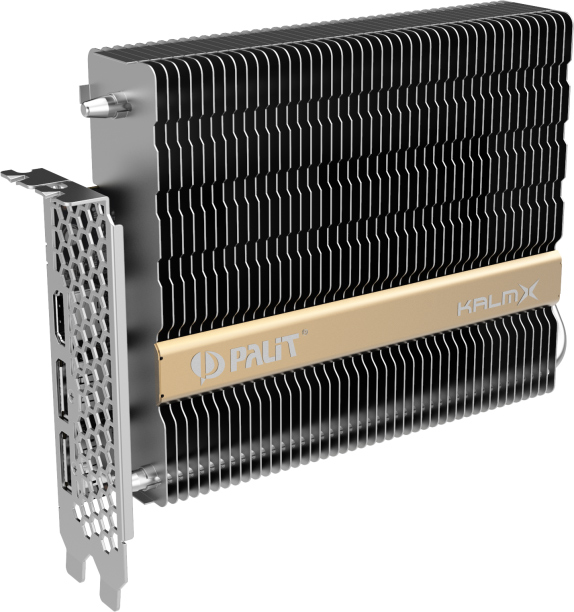A Passively-Cooled GeForce GTX 1650: KalmX by Palit
by Anton Shilov on February 7, 2020 5:00 PM EST
Passively-cooled video cards are rather rare these days, as the bulk of the market has made peace with today's dual fan actively cooled cards. Luckily, there are a still a few companies releasing passive designs, such as Palit Microsystems, who has introduced its fanless GeForce GTX 1650 KalmX.
The Palit GeForce GTX 1650 KalmX (NE5165001BG1-1170H) uses a custom PCB and comes with a sizable passive cooling solution. The double-wide heatsink incorporates a pair of heatpipes, and is considerably taller than the card as well. All told, with the heatsink factored in, the card measures 178 mm long and is 138 mm high. And unsurprisingly, given the strict thermal limitations in play, Palit is playing things conservatively here, and the card runs at NVIDIA official GTX 1650 reference clockspeeds of 1485 MHz/1665 MHz (base/boost).
Typical for GTX 1650 cards, Palit is using 4 GB of 8 Gbps GDDR5 memory here. The card has two DisplayPort 1.4a outputs and one HDMI 2.0b port.
Officially, Palit rates the card for a TDP of 75W; and judging from what we've seen with other GTX 1650 cards, that's probably a bit conservative as well. Which is all the better for Palit, since it makes their job of passively cooling the video card all the easier. The other upside of being a sub-75W card is that an auxiliary PCIe power plug isn't required, so the card can be dropped into a system and immediately used with no further internal wiring.
Palit has not revealed an MSRP for the GeForce GTX 1650 KalmX. NVIDIA’s regular MSRP for the GTX 1650 ($149), though I wouldn't be too surprised to see Palit charge a premium for a unique, passively-cooled card.
Related Reading:
- Palit Announces KalmX: A Passively-Cooled GeForce GTX 1050 Ti Graphics Card
- Akasa's Turing: A Passively-Cooled Chassis for Intel’s Bean Canyon NUC
- Compulab Passively-Cooled Airtop2 Inferno with GeForce GTX 1080
- Calyos NSG Cube: Passively Cooled SFF PC with Intel Core and GeForce GTX 1060
- GALAX Launches Low Profile GeForce GTX 1050 OC and 1050 Ti OC
- GIGABYTE Quietly Launches Low Profile GeForce GTX 1050, 1050 Ti Graphics Cards
- MSI Adds Low-Profile GeForce GTX 1050 Ti to Lineup
Source: Palit













34 Comments
View All Comments
Alistair - Sunday, February 9, 2020 - link
I'm not a rabid fanboy. You get 38 percent more performance per dollar, not 8. You can passively cool the super if you just turn the fans off and lower the power budget, just make sure you buy the best one, like a Gaming X.I think people seemed to miss my point. Passively cooled systems aren't good unless the heat sink is larger than the ones with fans. Otherwise you can just turn the fans off and use those instead. Adjust the power limit yourself.
Spunjji - Monday, February 10, 2020 - link
The heatsink also needs to have widely spaced fins, not be too encumbered by brackets, and ideally extend far enough over the top of the PCB to allow for a little convection.DirtyLoad - Monday, February 10, 2020 - link
I don't have time to do the calculations, so please tell me: does that 38% apply after turning down the thermals and turning off the fan?BenSkywalker - Monday, February 10, 2020 - link
Without a six pin connector and with fans off 38%?You know that is absurd to even imply.
A5 - Saturday, February 8, 2020 - link
The target market for this doesn’t care.Lord 666 - Sunday, February 9, 2020 - link
Hi, I am one of the accidentally targeted market for this. Don’t care about all out performance but will gladly pay a premium for noise reduction/elimination in my home office due to my clinically diagnosed ADD. My current rig is a 9900k using the integrated graphics without any case fans. Need a bit more graphics power along with dual DP, so this is perfect. Just wish it was from Gigabyte or Asus.sonny73n - Sunday, February 9, 2020 - link
It should have the cooling fins stacked 90 degree to the bracket so the front case fans can push air thru easier. How stupid.Korguz - Sunday, February 9, 2020 - link
yea.. ans make hiw many pcie slots unusable in the process ?? that would of been stupid...lmcd - Sunday, February 9, 2020 - link
I'd contend there's often a closer case fan on the side of the case that can pull heat out.jeremyshaw - Sunday, February 9, 2020 - link
Modern case design going to all glass/plastic side panels, which usually negates side panel fans nowadays.